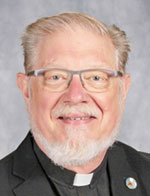That All May Be One / Fr. Rick Ginther
Festival reminds us religions are a mystery to embrace with love
 Festival of Faiths 2024 is in the books. It was a delightful time to be among so many people of various faith traditions.
Festival of Faiths 2024 is in the books. It was a delightful time to be among so many people of various faith traditions.
Curious and respectful Muslims, Jews, Sikhs, Latter Day Saints, Christians and Catholics approached our booth.
Questions, answers and conversations kept Deacon Steve Hodges of SS. Peter and Paul Cathedral Parish in Indianapolis, archdiocesan coordinator of evangelization and discipleship Anita Bardo, and me engaged.
One statement brought me up short: Catholicism is the one, true religion.
I know the Church’s teaching of the past. I am aware that the Second Vatican Council did speak of this. But how it spoke was neither judgmental nor intentionally exclusive.
In “Dignitatis Humanae,” we read:
“First, the council professes its belief that God himself has made known to mankind the way in which men are to serve him, and thus be saved in Christ and come to blessedness. We believe that this one true religion subsists in the Catholic and apostolic Church, to which the Lord Jesus committed the duty of spreading it abroad among all men.”
Human beings are by nature searchers for the divine. The document states that this curiosity is an obligation to be pursued. And it is the Church’s obligation to share what it knows and believes.
But not with coercion. Respect for those seeking and worshipping in faith is to be observed. By the Church. And by the state.
In continuing to examine “Dignitatis Humanae,” we read, “[Christ] spoke to the Apostles: ‘Go, therefore, and make disciples of all nations, baptizing them in the name of the Father and of the Son and of the Holy Spirit, teaching them to observe all things whatsoever I have enjoined upon you’ [Mt 28:19-20]. On their part, all men are bound to seek the truth, especially in what concerns God and his Church, and to embrace the truth they come to know, and to hold fast to it” (#1).
The Council likewise professes its belief that it is upon the human conscience that these obligations fall and exert their binding force. The truth cannot impose itself except by virtue of its own truth, as it makes its entrance into the mind at once quietly and with power.
“Religious freedom, in turn, which men demand as necessary to fulfill their duty to worship God, has to do with immunity from coercion in civil society. Therefore, it leaves untouched traditional Catholic doctrine on the moral duty
of men and societies toward the true religion and toward the one Church of Christ” (#1).
Religious pluralism is the state of being where every individual in a religiously diverse society has the rights, freedoms and safety to worship, or not, according to his or her conscience.
With the expression in the document’s original Latin “subsistit in,” the Second Vatican Council sought to harmonize two doctrinal statements. On the one hand, the Church of Christ, despite the divisions which exist among Christians, continues to exist fully only in the Catholic Church. On the other hand, it also teaches that “outside of her structure, many elements can be found of sanctification and truth,” that is, in those Churches and ecclesial communities which are not yet in full communion with the Catholic Church (“Dogmatic Constitution on the Church,” #8).
But with respect to these, it needs to be stated that “they derive their efficacy from the very fullness of grace and truth entrusted to the Catholic Church” (“Dominus Iesus” #16).
The Second Vatican Council’s “Declaration on the Relation of the Church to Non-Christian Religions” (“Nostra Aetate”) states, “In her task of promoting unity and love among men, indeed among nations, [the Catholic Church] considers above all in this declaration what men have in common and what draws them to fellowship” (#1).
The declaration affirms that “The Catholic Church rejects nothing which is true and holy in these religions,” but rather looks “with sincere respect upon those ways of conduct and of life, those rules and teachings, which, though differing in many particulars from what she holds and sets forth, nevertheless often reflect a ray of that truth which enlightens all men” (#2).
I hope this helps us all to better understand how the Church speaks of itself, other churches and ecclesial communities, and other religions. Ultimately, for me, how God works through the Church is amazing. And how God works through other Christians and other religions is a mystery to be embraced with love.
(Father Rick Ginther is director of the archdiocesan Office of Ecumenism and Interreligious Affairs. He is also the pastor of Our Lady of Lourdes Parish in Indianapolis.) †
 Festival of Faiths 2024 is in the books. It was a delightful time to be among so many people of various faith traditions.
Festival of Faiths 2024 is in the books. It was a delightful time to be among so many people of various faith traditions.